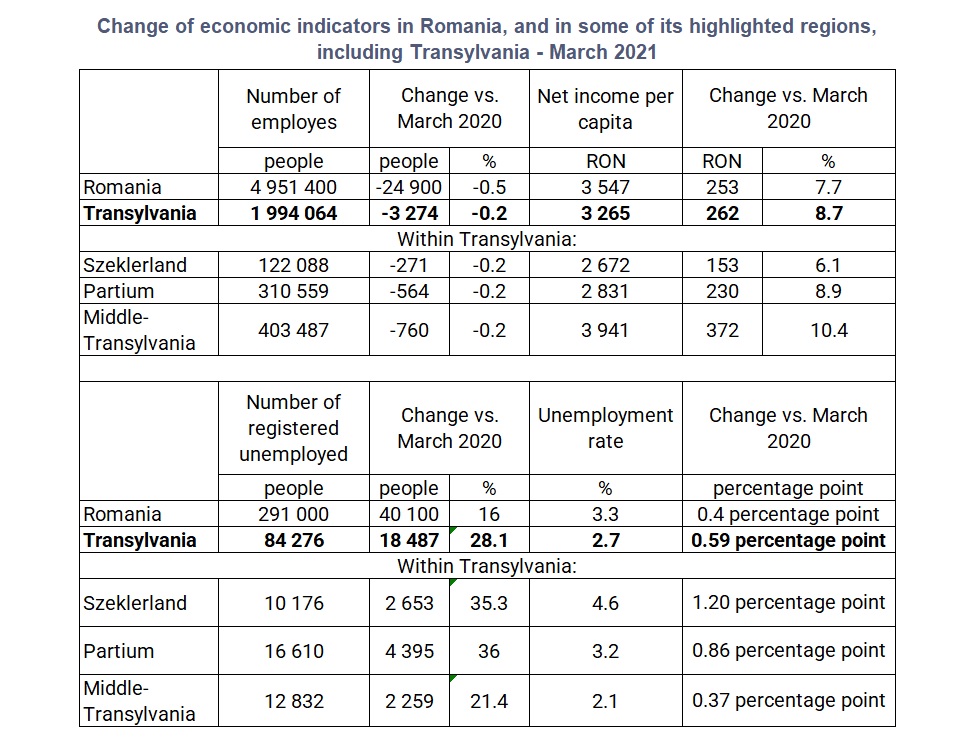The number of people registered as unemployed in Transylvania was 84,300 in March 2021, a 28.1 percent increase compared to the same period last year; the unemployment rate was 2.7% – reports the Erdélystat.
The number of employed people in Transylvania in March 2021 was 1,994,000, which is 3,300 lower than in March 2020, meaning a 0.2% decrease. The decrease was primarily in the service sector. The net average income per capita in Transylvania in March 2021 was RON 3,265 (EUR 663). Within Transylvania, the lowest income per capita was in Szeklarland, RON 2,672 (EUR 543), while in Partium, it was RON 2,831 (EUR 575), and in Middle-Transylvania, RON 3,941 (EUR 800).

Number of employed people
The number of employed people in Romania in March 2021 was 4,951,000, which is 24,900 lower than one year ago, meaning a 0.5 percent decrease. The rate of decrease in Transylvania was lower than this (0.2 percent), while the number of employed people in March 2021 was 1,994,000. It is an auspicious sign, however, Romania saw a slight increase in the first three months of 2021, and in March, the number of employed people was 7,000 higher than in the previous month.
According to the March figures for Transylvania, 56.9 percent of those employed were working in the service sector, 40.7 percent were employed in industry and construction, and 2.4 percent had jobs in agriculture and forestry (silviculture). The number of employed in Transylvania in the service sector decreased by 2,200 year-over-year (-0.2 percent), while in industry and construction, this figure fell by 1,100 (-0.1 percent) and slightly increased in agriculture and forestry.
The net average income per capita in Romania in March 2021 was RON 3,547 (EUR 720), which shows a 7.7 percent increase compared to March 2020, while inflation was 3.1 percent. The net average income per capita in Transylvania, after an 8.7 percent increase, was RON 3,265 (EUR 663). The reason Transylvanian net average income is lower than the national average is that the net average income in Bucharest is outstandingly high – RON 4,748 (EUR 964) – compared to the other parts of the country, so it pulls up the national average.
When interpreting the data, it is also crucial to keep in mind that during the coronavirus pandemic, people with lower income (mainly working in the service sector and industry) had a higher chance of losing their jobs, meaning that before the pandemic, they pulled down the average income level. Another thing can also distort the net income data: In many cases, exactly those activities that had to be shut down during the pandemic, are the ones not sending statistical data to the authorities, and because of this, the statistics might be showing a more positive picture than the reality. At the same time, the increases in the minimum wage and food coupons contributed to an increase in income.
The number of registered unemployed in Romania in March 2021 was 291,000 in March 2021, a 16 percent increase compared to the same period of last year. In Transylvania, the number of registered unemployed was 84,300, following a 28.1 percent increase over the same period in the previous year, meaning that the increase in Transylvania was much higher than the national average. However, the good news is that the negative trend might be changing, as while after the continuous increase in the number of registered unemployed people during the pandemic, it finally decreased slightly this year (by 537 people) in March from February.
The unemployment rate in Romania on a national level in March 2021 was 3.3 percent, which is a 0.4 percentage point increase YoY. Although this rate is lower in Transylvania, 2.7 percent, the increase was bigger (0.59 percentage points) compared to last March.
The unemployment rate within Transylvania was the highest in Szeklerland, 4.6 percent, which means a 1.2 percentage point increase compared to March 2020.
If you are into the numbers and interested in this topic, you can also check out Erdélystat’s similar report from two years ago by clicking here.
Title image is from Erdélystat’s Facebook page